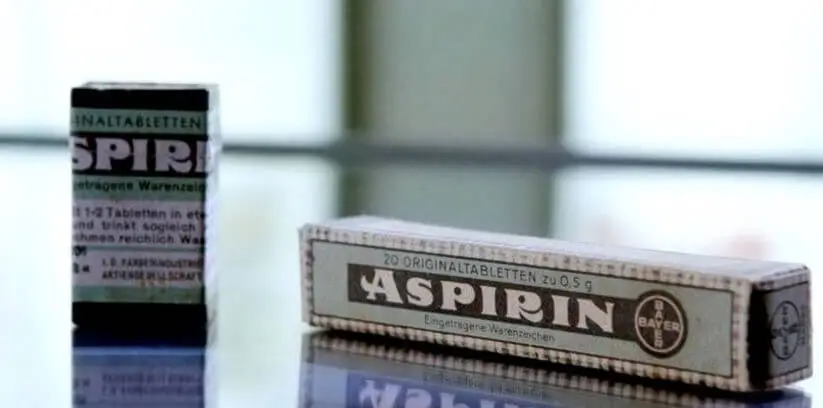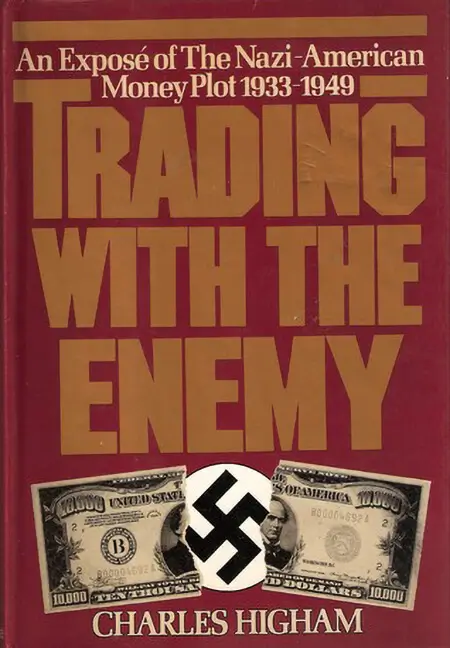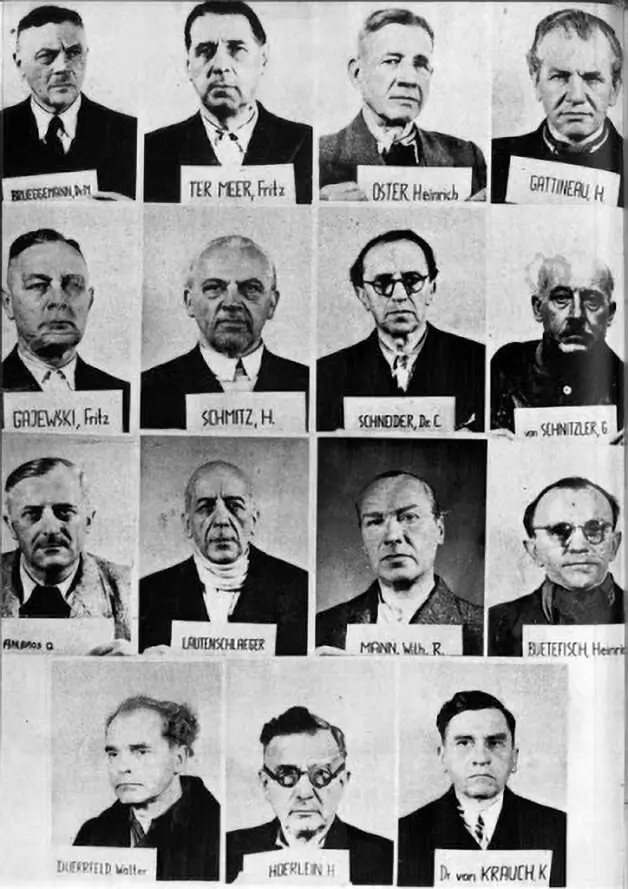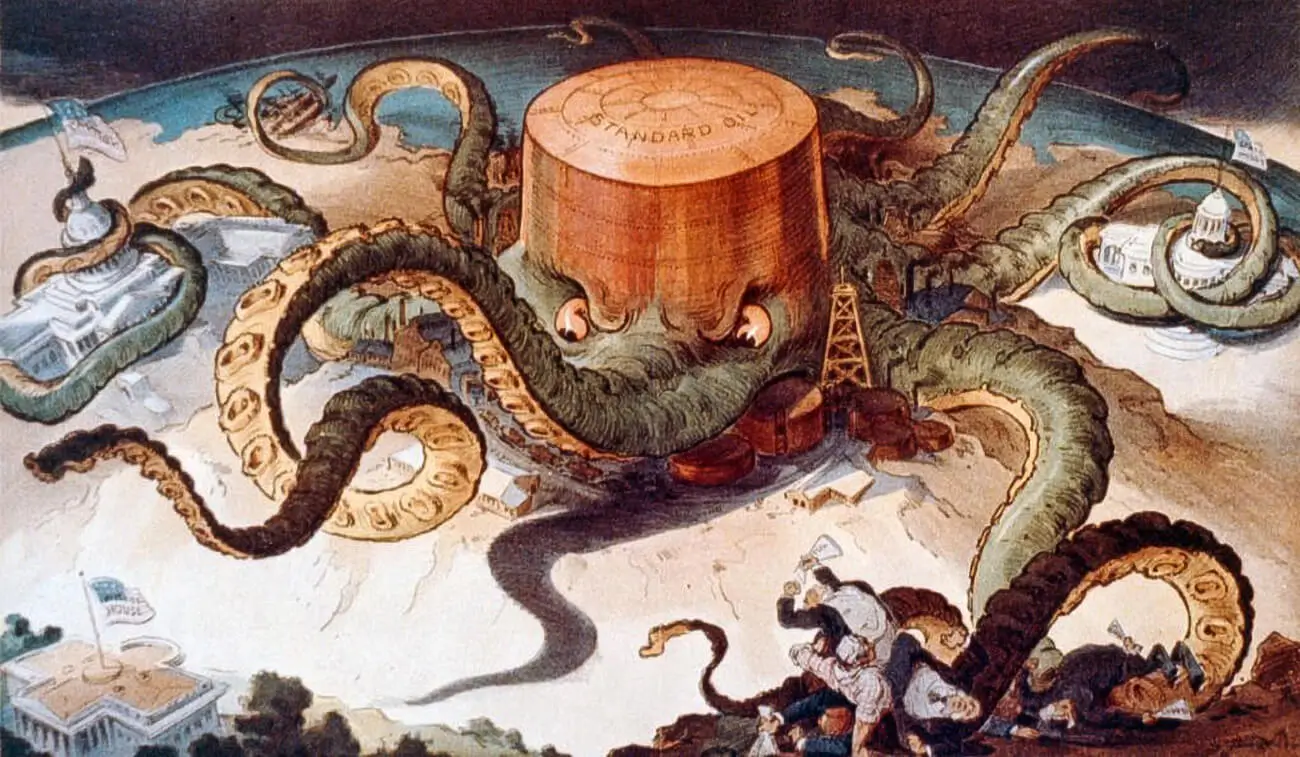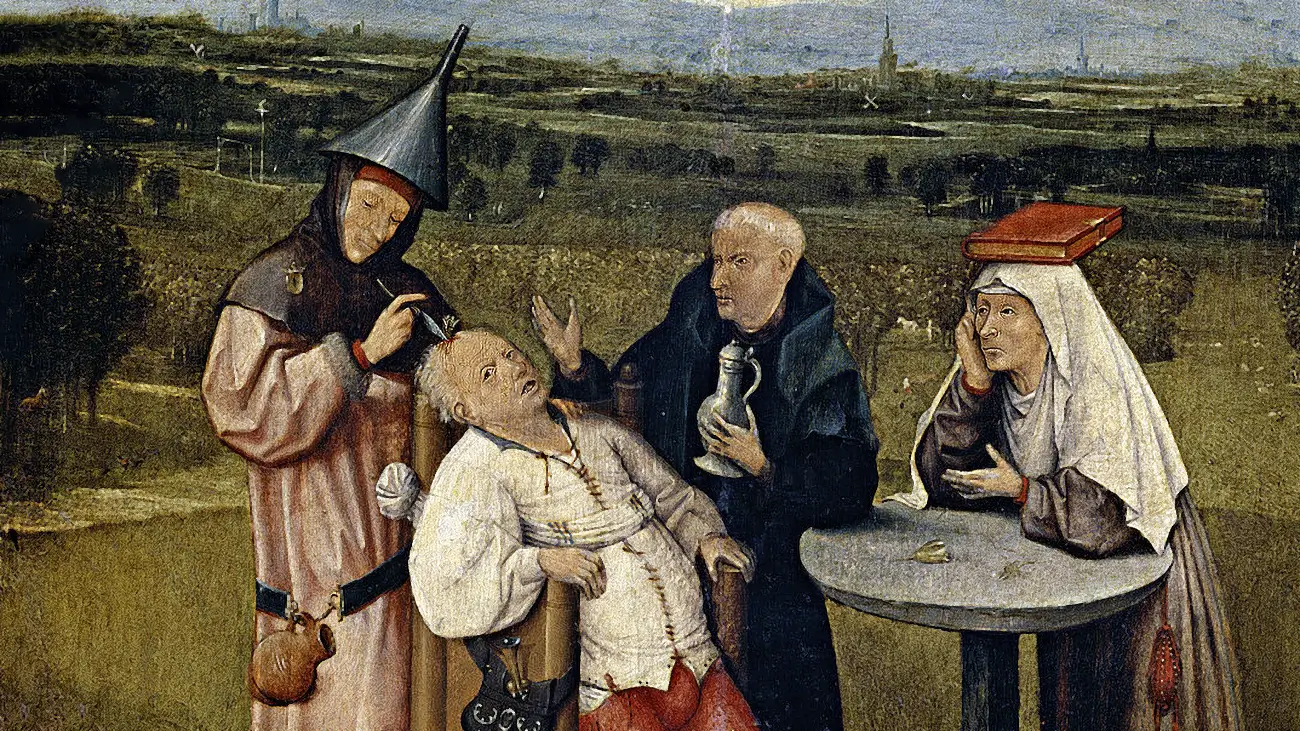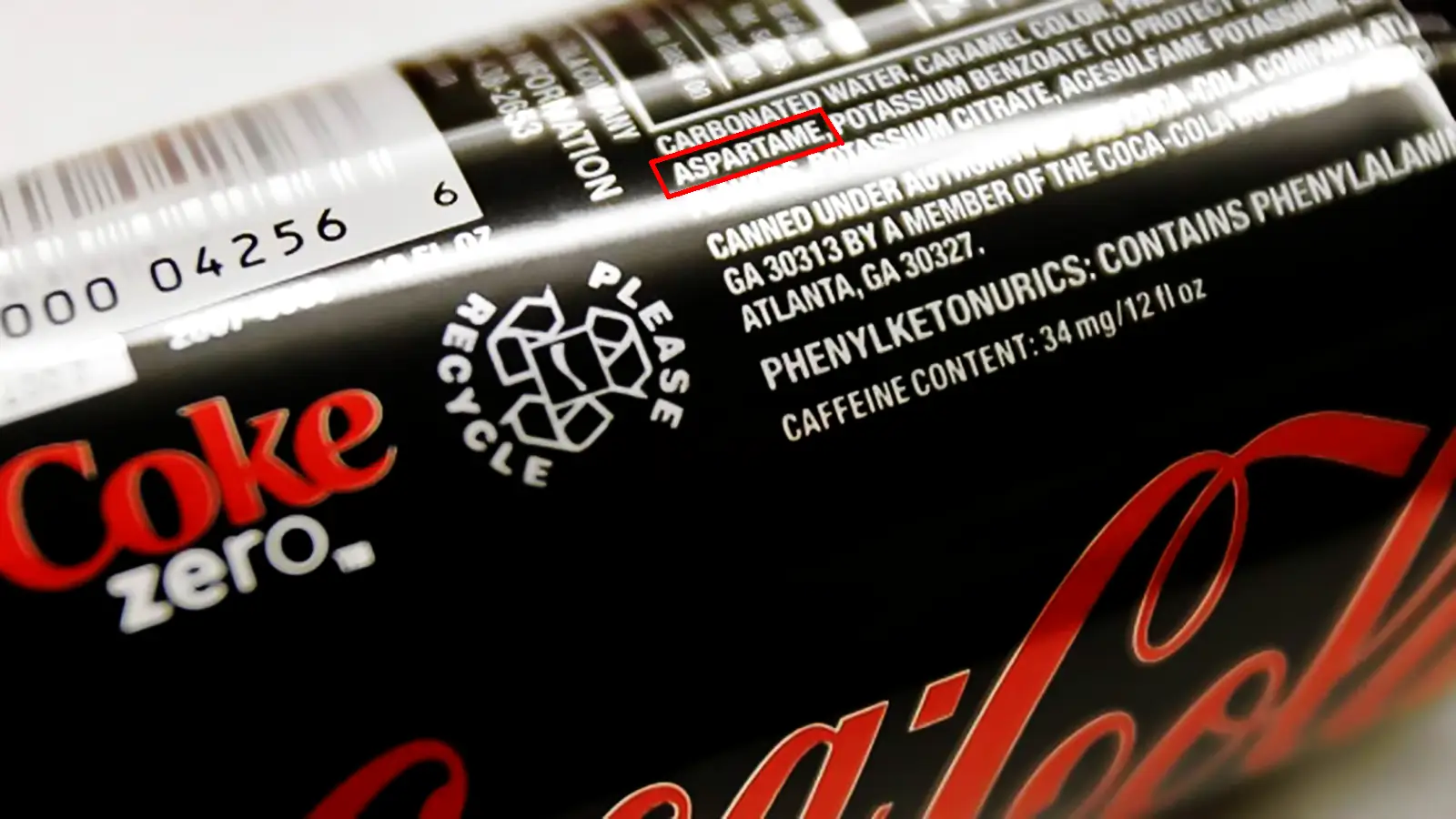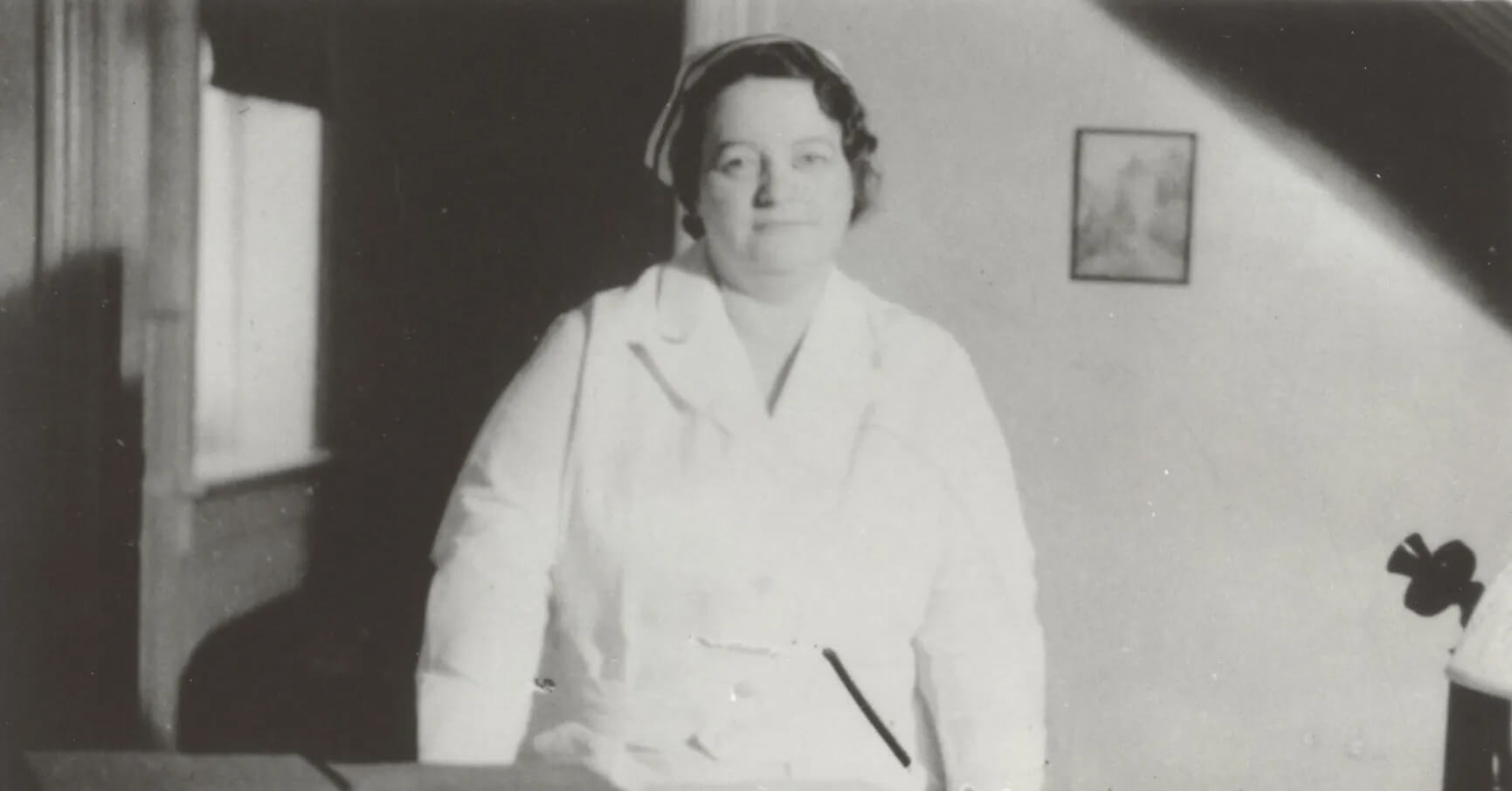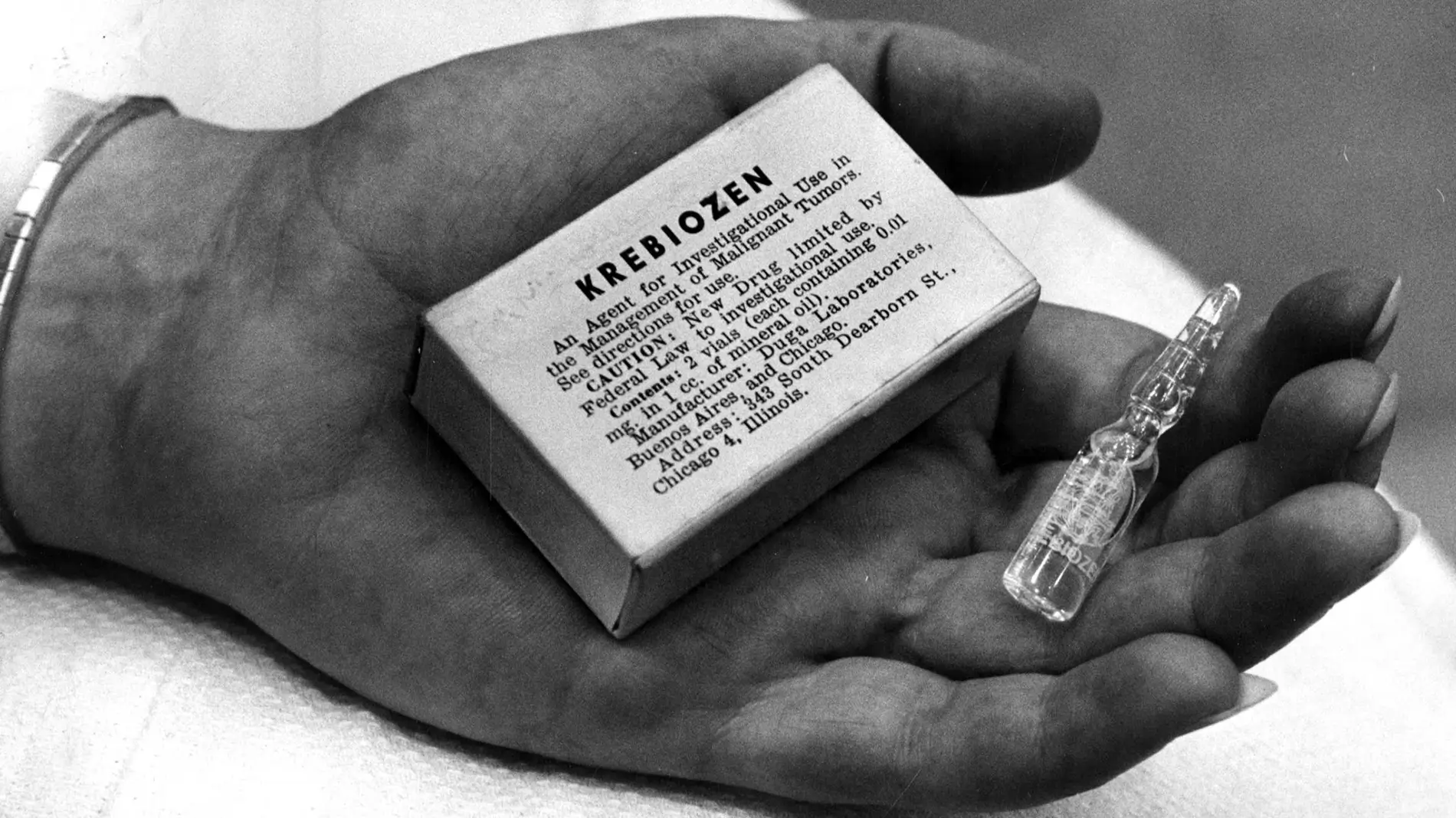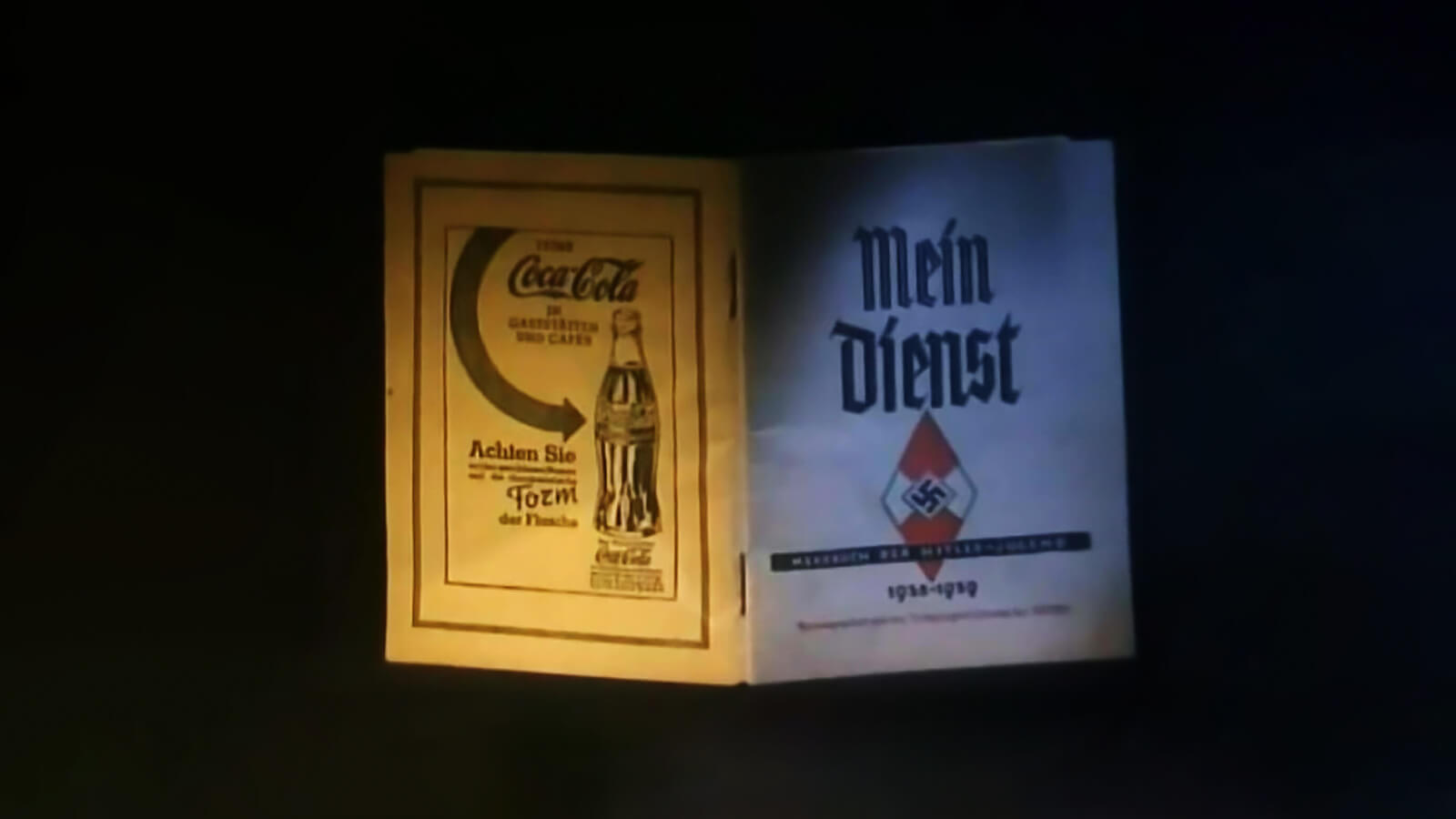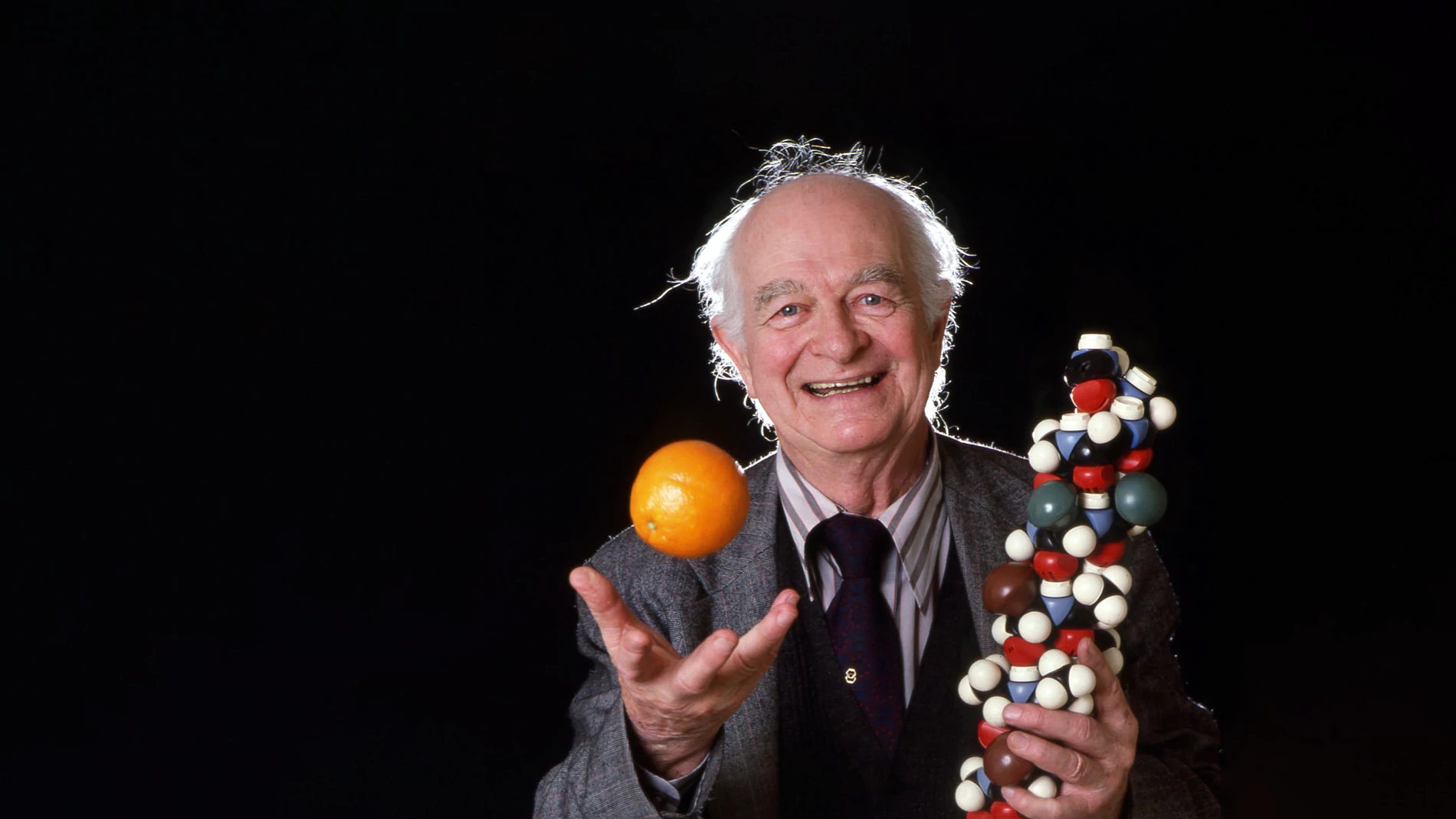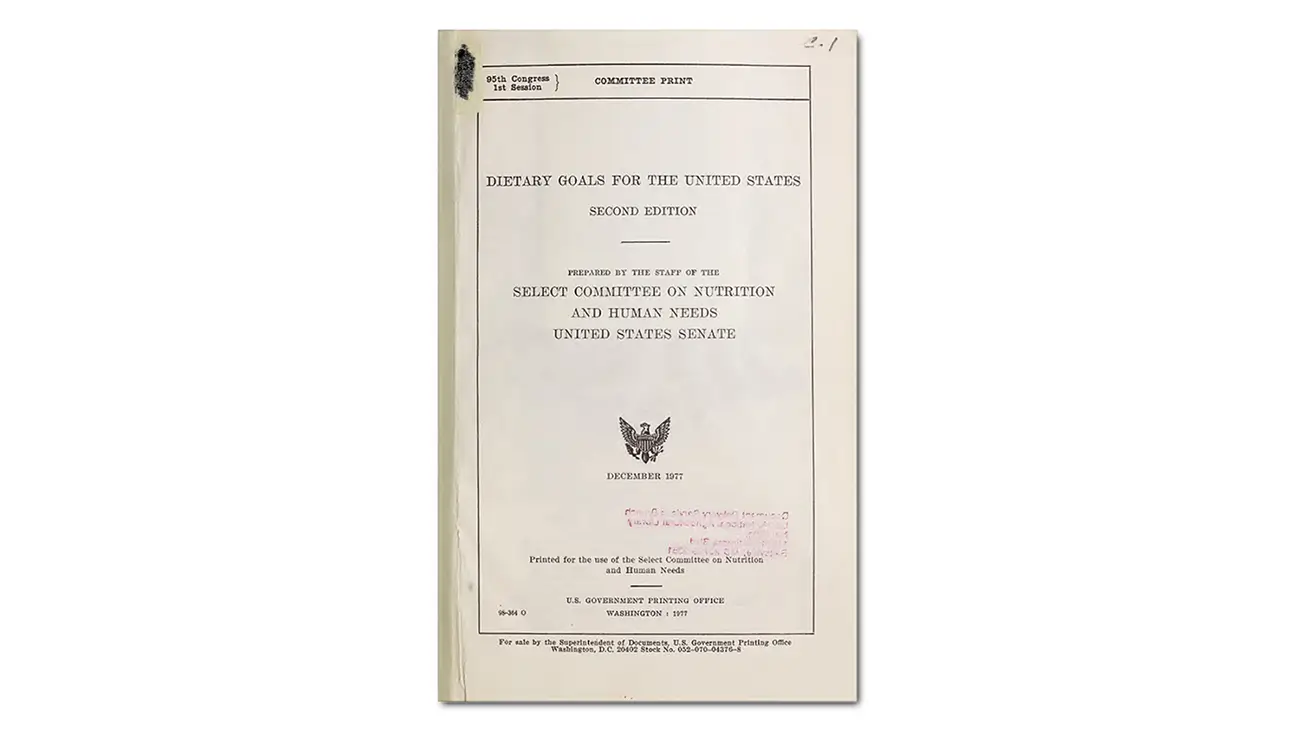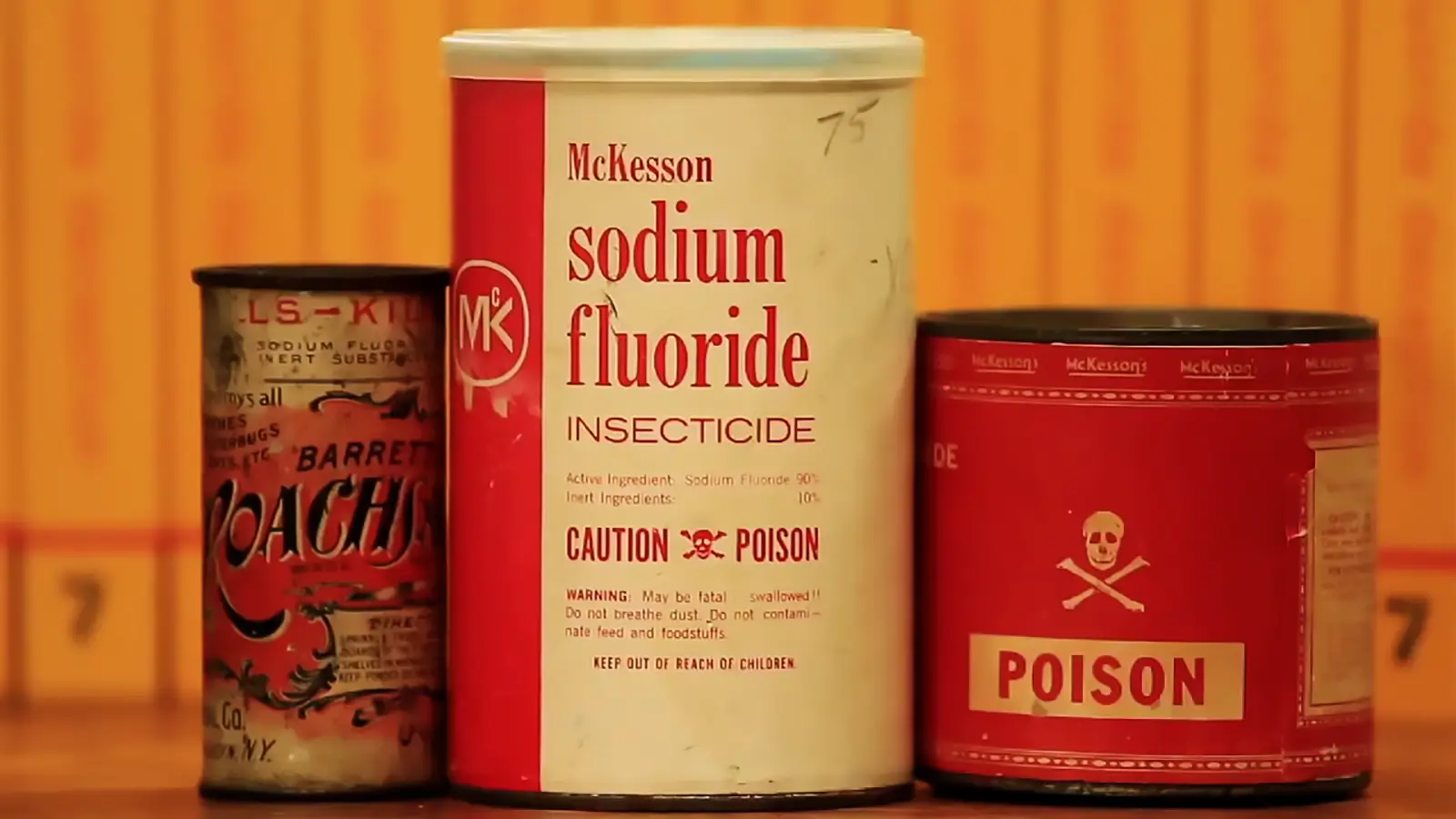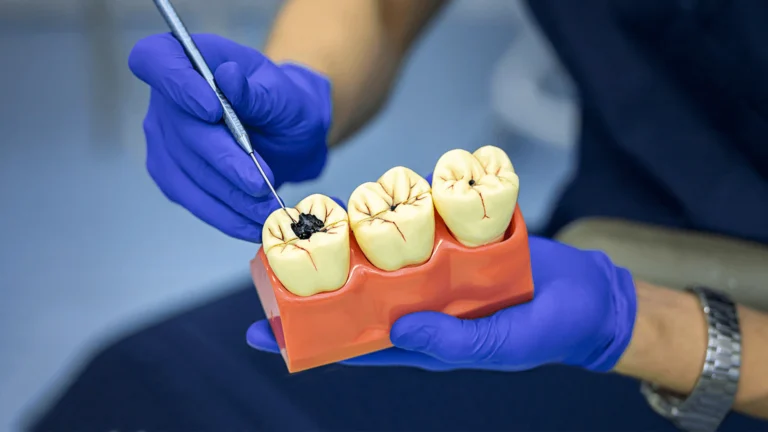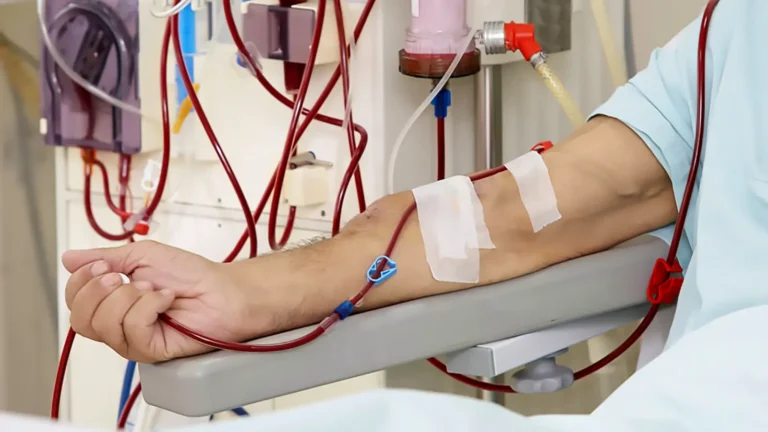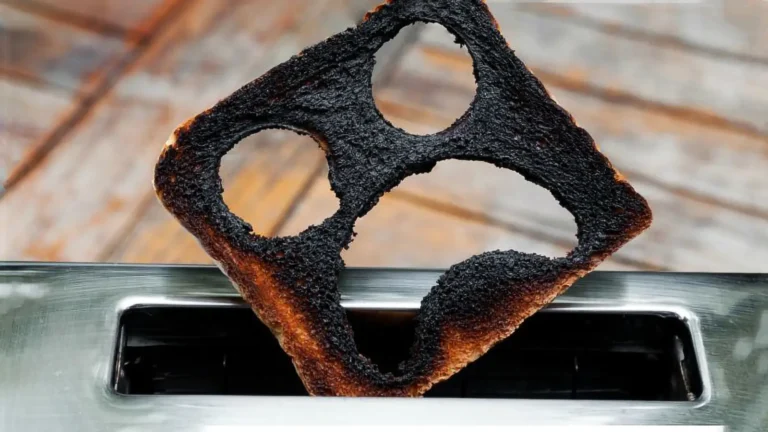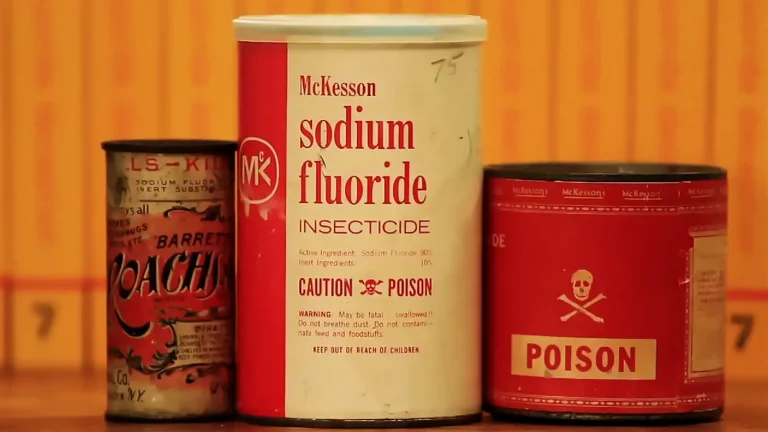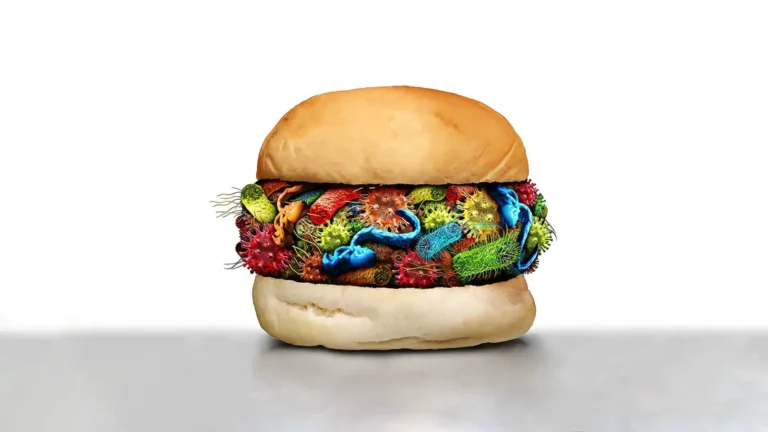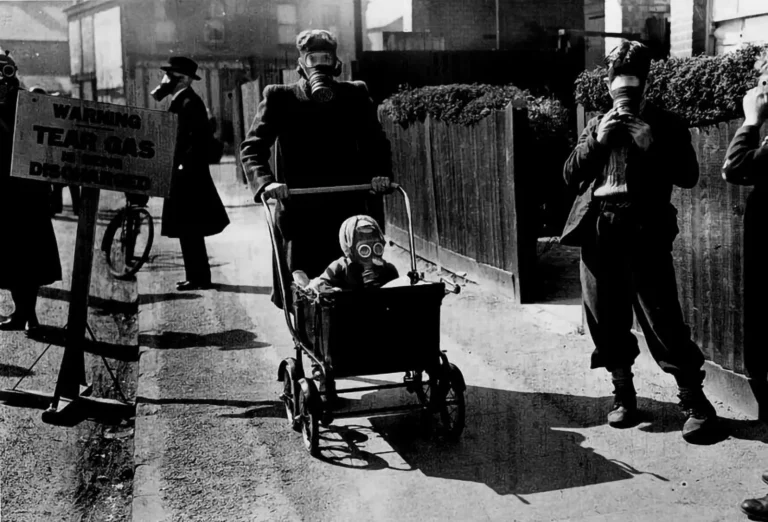A História da Grande Farmácia - IG Farben
A parte de Rockefeller, o monopólio da química e indústrias de medicamentos veio em cumprimento após a 2ª guerra mundial. A Standard Oil e a IG Farben cooperação fez isso em realidade.
Milos Pokimica
Escrito por: Milos Pokimica
Revisto Clinicamente Por: Dr. Xiùying Wáng, M.D.
Actualizado em 7 de Maio de 2023"A liberdade de uma democracia não é segura se o povo tolerar o crescimento do poder privado até um ponto em que este se torne mais forte do que o seu próprio Estado democrático. Que, na sua essência, é o fascismo - propriedade do governo por um indivíduo, por um grupo, ou por qualquer poder privado controlador".
- Presidente Franklin D. Roosevelt
A parte do monopólio de Rockefeller sobre as indústrias química e médica concretizou-se após a 2ª Guerra Mundial. E isto a uma escala global, não apenas nos EUA. A cooperação de Rockefeller e Rothschild tornou isto realidade.
Do outro lado do Atlântico, o cartel internacional da droga e dos produtos químicos, IG Farben, chamado "um Estado dentro de um Estado", foi criado em 1925 com o nome de Interessen Gemeinschaft Farbenindustrie Aktien Gesellschaft, geralmente conhecido por IG Farben, que significa simplesmente "O Cartel". A IG Farben detinha o monopólio absoluto do fabrico de todos os produtos químicos até à 2ª Guerra Mundial. Foi um dos principais financiadores do rearmamento da Alemanha, com especial interesse na produção de petróleo para o novo exército mecanizado alemão.
Tinha começado em 1904, através das seis principais empresas químicas na Alemanha iniciaram acordos para formar um cartel final, fundindo Badische Anilin, Bayer, Agfa, Hoechst, Weiler-ter-Meer, e Griesheim-Electron. O financiamento principal veio dos Rothschilds, que permaneceram representados pelo seu banqueiro alemão, Max Warburg, da M.M. Warburg Company, Hamburgo. Mais tarde, dirigiu os serviços secretos alemães durante a Primeira Guerra Mundial e foi consultor económico privado do Kaiser. Entretanto, o Kaiser foi derrubado, depois de perder a guerra, mas Max Warburg não foi exilado com ele, pois estava acima da política como agente de um poder superior, pelo que nunca foi para a Holanda. Em vez disso, tornou-se o consultor económico do novo governo. Representou também a Alemanha na Conferência de Paz de Paris. Max Warburg passou os tempos de descanso a restabelecer os laços familiares com o seu irmão, Paul Warburg, que, depois de ter criado a Lei da Reserva Federal em Jekyll Island, controlava o sistema bancário dos Estados Unidos durante a guerra. Esteve também presente em Paris como conselheiro financeiro de Woodrow Wilson.
Dois irmãos controlavam dois sistemas bancários diferentes em países que supostamente estavam em guerra uns com os outros. Antes da Segunda Guerra Mundial, Max Warburg fazia parte do conselho de administração da IG Farben. O seu irmão Paul Warburg fazia parte do conselho de administração da I.G. Farben, que era propriedade de uma filial americana. A família Warburg era uma proeminente família bancária alemã e americana de ascendência judaica alemã e originalmente judaica veneziana, altura em que usava o apelido del-Banco. No entanto, o banco Warburg em Hamburgo estava prestes a entrar em colapso em 1857, e os Rothschild injectaram grandes quantidades de dinheiro, tornando-se o novo proprietário do banco. A partir deste período, o M.M. Warburg Bank e os seus parceiros operaram efetivamente como frentes Rothschild. O primeiro membro a usar efetivamente o nome "Rothschild" foi Izaak Elchanan Rothschild, nascido em 1577. O nome Rothschild em iídiche significa "casaco vermelho". A I.G. Farben tornou-se rapidamente uma empresa com um património líquido de seis mil milhões de marcos, controlando mais de quinhentas empresas.
Enquanto a República de Weimar começava a desmoronar-se, os funcionários da IG, vendo a escrita na parede, iniciaram uma estreita cooperação com Adolf Hitler, fornecendo enormes quantidades de fundos necessários e influência política. Os progressos do cartel da I.G. Farben despertaram o interesse de outros industriais. Henry Ford ficou bastante impressionado e criou uma sucursal alemã da Ford Motor Company. A IG Farben comprou quarenta por cento das acções. De seguida, a I.G. Farben criou uma filial americana, denominada American I.G., em cooperação com a Standard Oil de New Jersey. Em 1930, a Standard Oil declarou que tinha adquirido o monopólio das bebidas na Alemanha, um negócio que tinha feito com a IG Farben. A empresa já estava a espalhar-se pela Europa indústria alimentar. Depois de o partido nazi ter chegado ao poder, John D. Rockefeller contratou o seu próprio agente de imprensa, Ivy Lee, para trabalhar com Hitler como consultor a tempo inteiro para o rearmamento da Alemanha. Já tinham decidido rearmar a Alemanha e realizar a Segunda Guerra Mundial, pelo que, já nessa altura, tinham começado os passos necessários para a criação da Segunda Guerra Mundial. De seguida, a Standard Oil construiu grandes refinarias na Alemanha para os nazis e continuou a fornecer-lhes petróleo durante a Segunda Guerra Mundial. Em 1939, Frank Howard, um vice-presidente da Standard Oil, visitou a Alemanha e fez alguns preparativos. Mais tarde, testemunhou:
"Fizemos o nosso melhor para elaborar planos completos para um modus vivendi que funcionasse durante todo o período da guerra, quer entrássemos ou não. "
Embora o seu nome seja pouco conhecido, Frank Atherton Howard era, na altura, um dos principais agentes que dirigiam as operações da Standard Oil. Foi também diretor do comité de investigação do Instituto Sloan Kettering durante a década de 1930. Era um agente dos Rockefellers e era bom no seu trabalho. O seu nomeado no Sloan Kettering, Dusty Rhoads, dirigiu a investigação que criou a quimioterapia. Durante a Segunda Guerra Mundial, Rhoads dirigiu o Serviço de Guerra Química em Washington, no quartel-general do Exército dos EUA. Os mesmos homens investigaram a cura para o cancro e os produtos químicos para matar pessoas em guerras, o que já me soa familiar. Homens que trabalham para o sindicato Rockefeller. Foi Frank Howard que, em 1939, influenciou Alfred Sloan e Charles Kettering, da General Motors, a fazerem grandes donativos ao Cancer Center, que passou a ter os seus nomes. A segunda mulher de Frank Howard era um importante membro da aristocracia britânica, a Duquesa de Leeds. Estou a escrever o seu estado civil apenas para que possamos compreender quem é na realidade o governo, a aristocracia, a democracia, o capitalismo, etc. É tudo a mesma coisa. Frank Howard foi o principal executivo na gestão das relações entre a Standard Oil e a IG Farben, trabalhando para coordenar os interesses de ambas as empresas. Liderou a investigação para o desenvolvimento da borracha artificial, que foi vital para a Alemanha na Segunda Guerra Mundial. Mais tarde, até escreveu um livro, "Buna Rubber". E a IG Farben foi também um apoiante direto, sem qualquer segredo, do Partido Nazi.
Numa conferência de industriais alemães com nazis como Hermann Goering e Heinrich Himmler, realizada em 20 de fevereiro de 1933, o IGF contribuiu com 400.000 marcos para o Partido Nazi. Foi o maior montante individual da soma total de 3 milhões de marcos de reich angariados nesta reunião pelos industriais alemães para a campanha eleitoral do Partido Nazi. A IG Farben contribuiu com quatro milhões e meio de marcos para o Partido Nazi em 1933; em 1945, a I.G. tinha fornecido ao Partido 40 milhões de marcos, uma soma que igualava todos os donativos da I.G. a todos os outros beneficiários durante esse período. Permitam-me que faça esta pergunta. Acham que os governos americano ou inglês não sabiam o que se estava a passar e de onde vinha o dinheiro? Eles planearam e financiaram toda a Segunda Guerra Mundial. Por exemplo, sem a ajuda clara do Standard Oil, a força aérea nazi nunca seria capaz de voar em primeiro lugar. Os aviões que constituíam a Luftwaffe precisavam de gasolina de chumbo tetraetilo para poderem voar. Na altura, apenas a General Motors, Standard Oil, e a Du Pont tinham a capacidade de produzir esta substância vital. Todas as empresas fora da Alemanha. Em 1938, Walter C. Teagle, director da Standard Oil, alojou Hermann Schmitz de I.G. Farben para obter 500 toneladas de chumbo tetraetilo da Ethyl, uma subsidiária britânica da Standard Oil. Um ano depois, Schmitz regressou a Londres e comprou um valor extra de 15 milhões de dólares de chumbo tetraetilo. De volta à Alemanha, que foi transformada em gasolina de aviação para a Luftwaffe.
Foi em 1927 que a Standard Oil e a IG Farben fundaram a empresa "Standard IG Farben". A Standard passou para a IG Farben as patentes sobre os processos de hidrogenação do carvão e os alemães deram-lhes as patentes sobre o fabrico de borracha sintética. Enquanto as potências europeias queriam evitar o crescimento da indústria alemã após a 1ª Guerra Mundial, os EUA gastaram enormes somas de dinheiro para reconstruir a Alemanha e nunca ratificaram o Tratado de Versalhes. Na verdade, não o governo dos EUA, mas o verdadeiro poder do Estado profundo por detrás disso. Até venderam obrigações alemãs no mercado financeiro dos EUA. Uma das mais importantes foi a "Union Banking Corporation" de George H. Walker. Este nomeou o seu genro, Prescott Bush, avô do Presidente dos EUA, George W. Bush, diretor da empresa.
O seu neto Presidente americano na altura em que George W. Bush estava na actualização 3.0 de mãos dadas com o Primeiro-Ministro israelita e a falar sobre a unidade dos povos americano e israelita na "guerra de terror", esquecendo o facto de que o seu avô Prescott estava a utilizar mão-de-obra escrava judia na sua fábrica de produção de aço em Auschwitz.
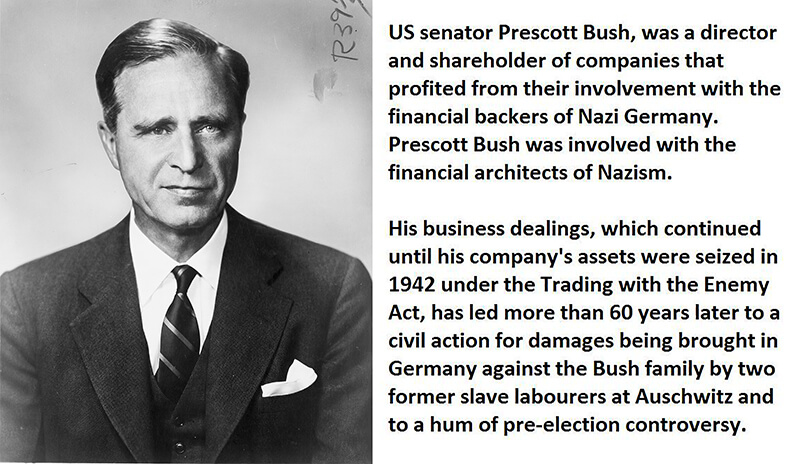
Na atualização 1.0, o pai de Prescott, Samuel P. Bush, presidente de longa data da empresa Buckeye Steel Castings, que era propriedade de Frank Rockefeller, irmão de John D. Rockefeller, fornecia peças para os caminhos-de-ferro de Edward Henry Harriman que, por sua vez, forneciam carregamentos ferroviários para a Standard Oil de John, que, por sua vez, obtinha financiamento monopolista dos Rothschild. O filho de Samuel, Prescott, era o diretor-geral de uma fábrica de aço nazi na Polónia, chamada Celestion Consolidated Steel, que, na atualização 2.0, reencaminhou o financiamento americano para o seu parceiro alemão Fritz Thyssen através da "Union Banking Corporation" em Nova Iorque. Fritz Thyssen celebra um contrato com a IG Farben para obter trabalho escravo judeu gratuito na fábrica de aço de Bush, no campo de concentração de Auschwitz.
Na atualização 2, Prescott Busch e Averell Harriman (filho do barão dos caminhos-de-ferro E. H. Harriman, 48º Governador de Nova Iorque, e um dos principais membros do grupo de anciãos da política externa conhecido como "Os Sábios" e membro da Skull and Bones) são apanhados ao abrigo da lei do comércio com o inimigo, quando o governo dos EUA intervém e confisca todas as acções da Union Banking Corporation.
Na atualização 4.0, o primeiro filho de Prescott, George Bush, é o diretor da CIA. George inclui o rei da droga Manuel Noriega na folha de pagamentos da CIA e permite que toneladas de cocaína cheguem às ruas da América através do Canal do Panamá.
Na atualização 5.0, o filho de George, o segundo George Bush, torna-se sócio do irmão mais velho de Osama bin Laden, Salem bin Laden, numa empresa petrolífera do Texas chamada Arbusto energy. Também na atualização 5, temos uma introdução ao obscuro irmão mais novo de George, Neil Bush, que rouba os idosos no escândalo Silverado Saving and Loan, que custou aos contribuintes americanos 1,3 mil milhões de dólares.
Na atualização final 6.0, temos George W. Bush, o presidente americano, a visitar um campo de extermínio em Auschwitz para fazer um discurso sobre "resistir ao poder do mal", onde o seu avô ajudou a construir a fortuna da família Bush com base em trabalho escravo judeu gratuito. George Herbert Walker, avô materno do presidente George H. W., também conseguiu grandes contratos com os alemães, antes e depois de 1933. No conselho de administração da sua "Walkers American Shipping and Commerce Company", com a sua Hamburg-America Line, estava Emil Helfferich, membro da "Freundeskreis Reichsführer- SS" e, até ao fim da Segunda Guerra Mundial, presidente da Deutsch-Amerikanische Petroleum Gesellschaft, mais tarde ESSO, e da Vacuum Oil Company em Hamburgo.
O principal problema para o ataque da Alemanha à União Soviética era a necessidade de combustível para tanques e aviões. Graças às patentes da Standard Oil, os alemães podiam produzir combustível a partir do seu próprio carvão, mas isso não era suficiente. Após o início da batalha na Europa, os ingleses ficaram irritados com os envios de materiais vitais dos EUA para a Alemanha nazi. A Standard Oil transferiu imediatamente o registo de toda a sua frota para o Panamá, para evitar a busca ou apreensão britânica. Estes navios deslocavam-se para levar petróleo para Tenerife, onde reabasteciam os petroleiros alemães para serem enviados para Hamburgo. Esta fraude foi desmascarada a 31 de março de 1941, quando o Departamento de Estado dos EUA publicou um relatório completo sobre os terminais de reabastecimento no México e na América Central e do Sul. O que aconteceu nessa altura? Não aconteceu nada. Não há notícia de que tenha sido tomada qualquer forma de ação porque tudo isto foi planeado a um nível mais elevado do que apenas o governo dos EUA.
Uma breve nota lateral, no entanto, é que em 17 de abril de 1945, o Chase National Bank foi levado a julgamento em tribunal federal sob a acusação de ter violado a Lei do Comércio com o Inimigo ao trocar marcos alemães por dólares americanos. Uma vez que várias nações rejeitaram a moeda alemã durante a guerra, os nazis utilizaram bancos internacionais como o Chase National dos Rockefellers para trocar a moeda por dinheiro que seria aceite como dólares, o que lhes permitiria comprar mais materiais necessários para prolongar a guerra.
À semelhança das opiniões contundentes do próprio Adolf Hitler sobre o controlo dos judeus na Alemanha, seria um desafio explicar o papel da I.G. Farben na era nazi. Porquê? Porque a I.G. Farben era maioritariamente controlada por banqueiros judeus, nomeadamente os Rothschild. Durante a década de 1920, foi acusada pelos nazis de ser uma "empresa judaica capitalista internacional".
O estudo exaustivo de Peter Hayes sobre a I.G. Farben salienta que, em 1933, a empresa tinha dez judeus nos seus conselhos de administração e não nos esqueçamos de que foi criada com financiamento dos Rothschild. A mesma empresa que tinha comprado a patente do pesticida Zyklon B, na década de 1920, e que mais tarde a distribuiu pelas câmaras de gás de Auschwitz. Para além de uma fábrica de óleo sintético e borracha em Auschwitz, a empresa também realizou experiências com medicamentos em reclusos vivos. Este aparelho utilizava tanta electricidade como toda a cidade de Berlim, e mais de 25.000 reclusos do campo morreram durante a sua construção. I.G. Farben acabou por construir o seu próprio campo de concentração, conhecido como Monowitz, que estava mais próximo da fábrica, a fim de reduzir a necessidade de se deslocar, já à beira da morte, prisioneiros à fome, diminuindo em vários quilómetros a eficiência do seu trabalho. A mesma empresa que nos dá aspirina.
Na fotografia abaixo, pode ver o campo de concentração construído para I.G. Farben Monowitz, e abaixo do campo o quartel-general do I.G. Farben intacto pela guerra e as bombas americanas (não por acidente).
O livro de Hingham, "Trading with the Enemy", documenta exaustivamente as actividades dos Rockefeller durante a Segunda Guerra Mundial.
Enquanto os aviões de Hitler despejavam toneladas de bombas sobre Londres, gastavam dinheiro em royalties sobre a gasolina que queimavam à Standard Oil, ao abrigo dos acordos de patentes existentes. Depois da guerra, a Rainha Elizabeth visitou os E.U.A. Ela ficou em apenas uma casa privada durante a sua visita, a propriedade do Kentucky de William Irish, da Standard Oil. Após a inacreditável destruição da maioria das cidades alemãs dos bombardeamentos aéreos da Segunda Guerra Mundial, os edifícios da I.G. permaneceram intactos por algum milagre. O "desmantelamento" da IG Farben, entre 1945 e 1952, pelo governo militar aliado, foi um processo semelhante ao "desmantelamento" do império da Standard Oil, por ordem judicial, em 1911. As três grandes empresas criadas (spin-offs da Farben) continuaram a comportar-se como um cartel.
A quem pertencem todos eles? Quem é o proprietário da Bayer, por exemplo?
A resposta é o cartel bancário internacional. Em 1939, enquanto se tornou claro que a Alemanha em breve seria impopular nos Estados Unidos, a Standard Oil ajudou I.G. Farben a cobrir as suas explorações americanas no domínio da droga e da química. A American IG foi formada e transferiu grande parte das finanças para o mercado americano, comprando a Winthrop Chemical, a Grasseli Chemical Works (também conhecida como General Aniline Works), a Agfa-Film Company, a Sterling Products Company e as empresas Magnesium Development. A Standard Oil recebeu 15% das acções do novo fundo químico germano-americano. Os esforços para envolver a empresa DuPont nesta fusão falharam parcialmente. Entre os diretores da empresa "encoberta" estavam Walter Teagle (presidente da Standard Oil Company), Paul Warburg (agente dos Rothschild) e Edsel Ford. A direção da American I.G. tinha três gestores do Federal Reserve Bank de Nova Iorque. A American I.G. também tinha ligações com o Bank of Manhattan (que mais tarde se tornou o Chase Manhattan), a Ford Motor Company, a Standard Oil of New Jersey e a A.E.G. (German General Electric). Três membros alemães e não americanos do conselho de administração desta I.G. americana foram considerados culpados nos Julgamentos de Crimes de Guerra de Nuremberga. Entre estes alemães encontrava-se Max Ilgner, diretor dos escritórios da I.G. Farben N.W. Seven em Berlim, ou seja, o gabinete de informações nazi antes da guerra. Com Pearl Harbor e a entrada dos Estados Unidos na Segunda Guerra Mundial, a IG Farben americana optou por encobrir a sua origem alemã e as suas alianças, com a ajuda da Standard Oil. Converteu o seu nome para General Aniline & Film Corporation pouco antes do ataque a Pearl Harbor. Antes de o fazer, a IG americana comprou um número não revelado de acções da Monsanto Chemical, Drug Incorporated, Mission Corporation, Dow Chemical, Schering & Company, Ozalid Corporation, Antidolar Company, Aluminum Corporation, Standard Oil of California, Standard Oil of Indiana, Standard Oil of New Jersey e DuPont Company. Também adquiriu a Hoffman-LaRoche Company. Sob os nazis, a filial alemã da empresa química Standard Oil era simplesmente uma única empresa. Foi fundida com centenas de acordos de cartel.
A I.G. Farben foi dirigida, até 1937, pela família Warburg. O agente bancário de Rockefeller, que ajudou a conceber a eugenia na Alemanha nazi e que, na realidade, não passava de um agente do sindicato Rothschild. Após o ataque alemão à Polónia em 1939, a Standard Oil prometeu manter a fusão com a I.G. Farben mesmo que os Estados Unidos entrassem na guerra. A fusão foi provavelmente planeada pelo cartel bancário Rothschild de Londres antes da guerra. Rockefeller representava, até certo ponto, os interesses da família Rothschild do outro lado do Atlântico, mas o que está em causa é a mesma força de controlo que financiou tudo isto. Quando os soldados americanos entraram na cidade fabril de Frankfort, ficaram espantados ao descobrir os edifícios em perfeitas condições e a enorme fábrica da empresa alemã IG Farben Chemical Trust intacta. Os aviadores americanos demoliram completamente todas as outras estruturas da cidade. A fábrica da Farben em Frankfort, uma das maiores construções do país, permaneceu milagrosamente intacta. Não foi por acaso que o governo da Alemanha do pós-guerra, o Governo Militar Aliado, também estabeleceu os seus escritórios no edifício da I.G. Farben. Esta administração era chefiada pelo general Lucius Clay, que mais tarde se tornou sócio do Lehman Brothers. O que os "doughboys" também não sabiam era que o Secretário da Guerra, Robert P. Patterson, era um advogado Rockefeller. Ele foi nomeado pelo presidente Roosevelt, recém-saído da Dillon, Read e Company. A empresa Dillon-Read não só é uma subsidiária da Rockefeller como foi a casa bancária que financiou a IG Farben alemã e tratou dos pormenores comerciais da formação da empresa americana de "encobrimento" do cartel químico alemão.
Na medicina, o cartel Rockefeller continua a proteger o seu monopólio médico. O seu controlo da indústria do cancro passa pelo Sloan Kettering Cancer Center. Todas as grandes empresas farmacêuticas são financiadas, cada uma pelo seu executivo do Chase Manhattan Bank, da Standard Oil Company ou de outras empresas Rockefeller. O American College of Surgeons mantém o controlo dos hospitais através do poderoso Hospital Survey Committee, com membros nomeados por e para representar o controlo Rockefeller. Do outro lado do Atlântico, passava-se a mesma coisa.
BASF SE (Alemanha) - A maior empresa química do mundo! Em 2020, registou um volume de negócios de 60 mil milhões de euros.
Bayer I.G. (Alemanha) - Uma das maiores empresas farmacêuticas do mundo. Começou como uma empresa de corantes e foi consolidada na IG Farben em 1881.
Hoechst AG (Alemanha) - um dos maiores fabricantes farmacêuticos do mundo, agora Sanofi-Aventis;
Sanofi-Aventis - (França), criada por uma fusão em 2004 entre a Aventis(1999 fusão da Rhone-Poulenc com a Hoechst AG (IG Farben)) e a Sanofi;
Wyeth - (EUA) Em 2002 foi renomeada de Sterling Drug Inc. (a subsidiária americana da IG Farben), fundindo-se depois com a Pfizer em 2009.
Pfizer - (EUA), Fundada em 1849 em Nova Iorque. Comprou a Warner-Lambert, Parke-Davis, Upjohn, Pharmacia (Monsanto), e Wyeth (a subsidiária americana da IG Farben).
A Agfa-Gevaert N.V. (Agfa) fornece aos hospitais e a outras organizações de cuidados de saúde produtos e sistemas de imagiologia, bem como sistemas de informação e sistemas industriais de jato de tinta para as indústrias gráfica e de impressão. Atualmente, o comércio da Agfa-Gevaert é 100% business-to-business.
Referências:
Passagens seleccionadas de um livro: Pokimica, Milos. Go Vegan? Revisão da Ciência-Parte 2. Kindle ed., Amazon, 2018.
Publicações Relacionadas
Você tem alguma dúvida sobre saúde e nutrição?
Eu adoraria ouvir de você e respondê-las em meu próximo post. Agradeço sua contribuição e opinião e espero ouvir de você em breve. Eu também convido você a siga-nos no Facebook, Instagram e Pinterest para mais conteúdos sobre dieta, nutrição e saúde. Pode deixar um comentário e ligar-se a outros entusiastas da saúde, partilhar as suas dicas e experiências e obter apoio e encorajamento da nossa equipa e comunidade.
Espero que este post tenha sido informativo e agradável para si e que esteja preparado para aplicar os conhecimentos que aprendeu. Se achou este post útil, por favor partilhá-lo com os seus amigos e familiares que também possam beneficiar com isso. Nunca se sabe quem poderá precisar de alguma orientação e apoio no seu percurso de saúde.
– Você Também Pode Gostar –

Aprender Sobre Nutrição
Milos Pokimica é médico de medicina natural, nutricionista clínico, escritor de saúde e nutrição médica, e conselheiro em ciências nutricionais. Autor da série de livros Go Vegan? Revisão de Ciênciaopera também o website de saúde natural GoVeganWay.com
Medical Disclaimer
GoVeganWay.com traz análises das pesquisas mais recentes sobre nutrição e saúde. As informações fornecidas representam a opinião pessoal do autor e não pretendem nem implicam substituir aconselhamento, diagnóstico ou tratamento médico profissional. As informações fornecidas são apenas para fins informativos e não se destinam a servir como substituto para consulta, diagnóstico e/ou tratamento médico de um médico ou profissional de saúde qualificado.NUNCA DESCONSIDERE o CONSELHO MÉDICO PROFISSIONAL OU adiar a BUSCA de TRATAMENTO MÉDICO por causa DE ALGO QUE TENHA LIDO OU ACESSADO por MEIO de GoVeganWay.com
NUNCA APLIQUE QUAISQUER MUDANÇAS de estilo de VIDA OU QUALQUER MUDANÇA COMO UMA CONSEQUÊNCIA DE ALGO QUE TENHA LIDO NO GoVeganWay.com ANTES de CONSULTORIA de LICENÇA MÉDICA.
No caso de uma emergência médica, ligue para o médico ou para o 911 imediatamente. GoVeganWay.com não recomenda ou endossa qualquer específicos, grupos, organizações, exames, médicos, produtos, procedimentos, opiniões ou outras informações que podem ser mencionadas dentro.
Sugestões do Editor –
Milos Pokimica é escritor especializado em saúde e nutrição e consultor em ciências nutricionais. Autor da série de livros Go Vegan? Revisão de Ciênciaopera também o website de saúde natural GoVeganWay.com
Artigos Mais Recentes -
Superior De Saúde De Notícias — ScienceDaily
- Why consciousness exists at allon Dezembro 15, 2025
Consciousness evolved in stages, starting with basic survival responses like pain and alarm, then expanding into focused awareness and self-reflection. These layers help organisms avoid danger, learn from the environment, and coordinate socially. Surprisingly, birds show many of these same traits, from subjective perception to basic self-awareness. This suggests consciousness is far older and more widespread than once believed.
- AI found a way to stop a virus before it enters cellson Dezembro 15, 2025
Researchers discovered a hidden molecular “switch” that herpes viruses rely on to invade cells. By combining AI, simulations, and lab experiments, they identified and altered a single amino acid that shut down viral entry. What once might have taken years was achieved far faster using computational tools. The findings open new possibilities for designing future antiviral treatments.
- New study shows some plant-based diets may raise heart disease riskon Dezembro 15, 2025
Researchers tracking over 63,000 adults found that high-quality, minimally processed plant foods significantly reduce cardiovascular risk. But when those plant foods are ultra-processed, the advantage disappears—and can even backfire. Some ultra-processed plant diets increased risk by 40%. The study urges a shift toward whole, naturally nutrient-rich plant foods.
- These simple habits could make your brain 8 years younger, study findson Dezembro 15, 2025
New research shows that your brain’s “true age” can shift dramatically depending on how you live, with optimism, restorative sleep, stress management, and strong social support acting like powerful anti-aging tools. Using advanced MRI-based brain-age estimates, scientists found that people with multiple healthy lifestyle factors had brains up to eight years younger than expected — even among those living with chronic pain.
- Anxiety and insomnia linked to sharp drops in key immune cellson Dezembro 15, 2025
Natural killer cells act as the immune system’s rapid-response team, but the stress of anxiety and insomnia may be quietly thinning their ranks. A study of young women in Saudi Arabia found that both conditions were linked to significantly fewer NK cells—especially the circulating types responsible for destroying infected or abnormal cells. As anxiety severity increased, NK cell levels dropped even further, suggesting a stress-driven weakening of immune defenses.
- Cannabis compounds show unexpected power against ovarian canceron Dezembro 15, 2025
Scientists have discovered that key compounds from cannabis—CBD and THC—show surprisingly strong effects against ovarian cancer cells. Used together, they slow cell growth, reduce colony formation, and may even block the cancer’s ability to spread. Even more promising, the treatment caused minimal harm to healthy cells and appears to work by restoring a disrupted signaling pathway that fuels tumor growth.
- Mayo Clinic neurosurgeon reveals 8 back pain myths to stop believingon Dezembro 15, 2025
Back pain is wrapped in persistent myths, but many are far from the truth. From misconceptions about heavy lifting and bed rest to confusion over posture, exercise, and surgery, Dr. Meghan Murphy breaks down what really causes pain and what actually helps. Her insights reveal that everyday habits, movement, and smart prevention often make a bigger difference than people realize.
PubMed, #vegan-dieta –
- Healthful and Unhealthful Plant-Based Diets and Their Association with Cardiometabolic Targets in Women Diagnosed with Breast Cancer: A Cross-Sectional Analysis of a Lifestyle Trialon Dezembro 11, 2025
CONCLUSIONS: Maintaining cardiometabolic risk factors within normal ranges is clinically relevant in BCS, and this may be more likely when a plant-based diet is consumed, especially if low in unhealthy plant foods.
- Dietary and Lifestyle Patterns and Their Associations with Cardiovascular and Inflammatory Biomarkers in Vegans, Vegetarians, Pescatarians, and Omnivores: A Cross-Sectional Studyon Dezembro 11, 2025
Background: Plant-based diets are associated with reduced cardiometabolic risk, yet the influence of lifestyle behaviors on these benefits remains insufficiently understood. Objective: To assess the combined impact of dietary patterns and lifestyle behaviors on body composition, lipid profiles, and inflammatory biomarkers in healthy young adults. Methods: In this cross-sectional study, 155 participants aged 18-39 years were categorized into four dietary groups: vegans (n = 48), vegetarians (n […]
- Functional and Nutritional Properties of Lion’s Mane Mushrooms in Oat-Based Desserts for Dysphagia and Healthy Ageingon Dezembro 11, 2025
Hericium erinaceus (Lion’s Mane mushroom) is a medicinal species recognised for its neuroprotective and antioxidant properties. This study investigated its potential as a functional ingredient in oat milk-based desserts formulated for individuals with dysphagia. Freeze-dried Lion’s Mane powder (LMP), containing high-quality protein (~16%, amino acid score 88%), dietary fibre (~31%), and phenolic compounds (72.15 mg GAE/g), was incorporated at varying levels using gelatin or iota-carrageenan […]
- “A football team with no midfield”: A qualitative analysis of anti-vegan stigma in Italyon Dezembro 7, 2025
A growing body of research has demonstrated the prevalence of unfavourable attitudes towards individuals who adhere to a vegan diet and has provided empirical evidence to support the existence of an anti-vegan ideology. The present study aims to contribute to extant knowledge by examining the social perception of veganism and vegans in Italy. Italy is a nation characterised by a traditional culture of food that serves as a significant catalyst for collective identification and national pride….
- Plant-based dietary index on the Mediterranean and a vegan diet: a secondary analysis of a randomized, cross-over trialon Dezembro 5, 2025
CONCLUSION: These findings suggest that, replacing animal products even with the “unhealthful” plant-based foods on a vegan diet was associated with weight loss.
Postagens aleatórias –
Postagens em destaque –
Últimas do PubMed, #dieta baseada em vegetais –
- Identification of effective plant-based oils for use in aquafeed: An evaluation of impact on gamete quality and developmental success using zebrafish (Danio rerio) as a screening organismpor Seyed-Mohammadreza Samaee on Dezembro 14, 2025
To evaluate the effectiveness of zebrafish as a screening system for identifying appropriate plant oils (POs) for aquafeed, Artemia nauplii (AN) were enriched with three single- cultivar olive oils (OO): Koroneiki, Parseh, and Arghavan. The resulting AN (ANKor, ANPar, ANArg, and AN36 [36 h starved AN, control]) were then fed to 360 fish (3.5 cm) for one month. The fatty acid (FA) profile of the AN was reflected in the ova and influenced both sperm motility and density, which in turn affected […]
- The Effect of Dietary Interventions on Human Vascular Function in the Context of Acute Psychological Stress: A Scoping Reviewpor Rosalind Baynham on Dezembro 14, 2025
Episodes of acute psychological stress increase the risk for cardiovascular diseases, partially through stress-induced impairments in vascular function. During psychologically stressful periods, individuals are more likely to consume unhealthy foods and fewer fruits and vegetables. Yet, the impact of dietary choices and their nutritional composition on vascular function in the context of psychological stress is unclear. In this scoping review, comprehensive database searches were carried out […]
- Plant-based diets, gut microbiota, blood metabolome, and risk of colorectal, liver and pancreatic cancers: results from a large prospective cohort study of predominantly low-income Americanspor Fangcheng Yuan on Dezembro 14, 2025
CONCLUSIONS: A diet high in healthy plant foods and low in animal foods was inversely associated with liver cancer risk and with CRC risk among screening-naïve participants. These associations may be partly mediated through gut microbiota and systemic metabolism.
- Vegetarian diet and likelihood of becoming centenarians in Chinese adults aged 80 years or older: a nested case-control studypor Yaqi Li on Dezembro 14, 2025
CONCLUSIONS: Targeting individuals of advanced age (80+ years) in China, we found that individuals following vegetarian diet had lower likelihood of becoming centenarians relative to omnivores, underscoring the importance of a balanced high-quality diet with animal- and plant-derived food composition for exceptional longevity, especially in the underweight oldest-old.
- Priority of nutrition and exercise in depression management: triangulating mini-review of past and recent evidence with clinical practice guidelinespor Shannon Rogers on Dezembro 14, 2025
CONCLUSIONS: Disparities that exist in leading depression management guidelines vis-à-vis inclusion of evidence-informed nutrition and PA/PE recommendations, warrant reconciliation. Evidence supporting anti-depressant WFPB nutrition and limiting pro-inflammatory animal-sourced food and UPF and supporting anti-inflammatory aerobic exercise and resistance training warrants being translated into national/international depression management guidelines as consistently as recommendations for…
- The effect of a diet based on vegetable and dairy protein on biochemical and functional indicators of sarcopenia in patients with liver cirrhosis: a randomized controlled trialpor Mahdiyeh Taghizadeh on Dezembro 13, 2025
CONCLUSIONS: In conclusion, a vegetable and dairy protein-based diet effectively inhibited significant elevations in ammonia levels compared to the standard diet in persons with liver cirrhosis; however, anthropometric parameters and muscle function did not differ between two groups.

